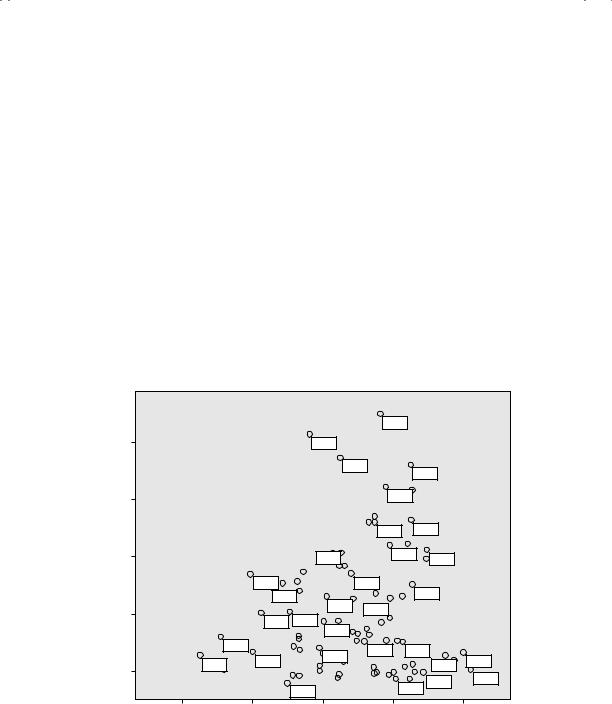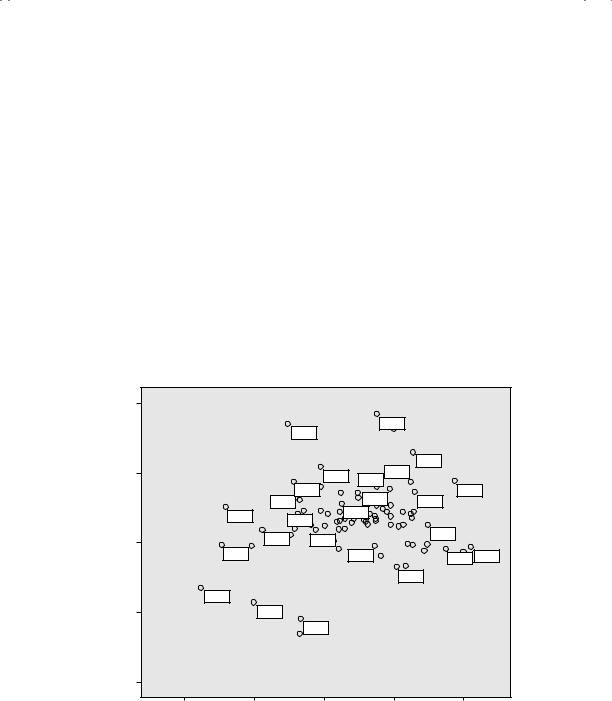
aswath_damodaran-investment_philosophies_2012
.pdf
490 |
INVESTMENT PHILOSOPHIES |
were investors who looked back at 1999 and bemoaned the fact that they missed getting out of stocks when the market topped at the end of that year. At that time, though, the signs were not so obvious. There were analysts who argued that the market was overvalued and indicators that supported that point of view, but there were just as many analysts, if not more, who saw the market continuing to rise and had supporting models.
In practice, there is almost never a consensus among investors on whether markets have hit bottom or peaked at the time that it occurs. It is an interesting fact that optimism about the future is greatest just as markets top out and the market mood is darkest just as markets turn around. To succeed at market timing, you cannot wait until a bottom has been established before buying or for a market top before selling. If you do, you will miss much of the subsequent payoff.
M a r k e t T i m i n g B a s e d o n F u n d a m e n t a l s
Just as the prices of individual stocks must reflect their cash flows, growth potential, and risk, entire markets (equity, bond, and real asset) have to reflect the fundamentals of these assets. If they do not, you can argue that they are misvalued. In this section, we consider two ways in which we can bring fundamentals into market timing models. In the first, we try to develop market timing strategies based on the level of fundamental variables—interest rates and economic growth, for instance. In the second, we try to extend the valuation techniques developed for individual stocks to markets.
F u n d a m e n t a l I n d i c a t o r s You can try to time markets by developing simple signals based on macroeconomic variables. In this section, we consider some of these signals—a few old and some new—that have been used by portfolio managers as market timing tools.
Short-Term Interest Rates Buy stocks when short-term rates (Treasury bills) are low and sell them when short-term rates are high, or so goes the conventional wisdom. But is there a basis to this advice? In Table 12.3, we examine stock returns under four Treasury bill scenarios: after a decline in rates of more than 1 percent over the prior year, a drop of between 0 and 1 percent, an increase in rates of less than 1 percent, and an increase of more than 1 percent between 1928 and 2001.

The Impossible Dream? Timing the Market |
|
491 |
|
|
T A B L E 1 2 . 3 Stock Returns and Treasury Bill Rates |
|
|
||
|
|
|
|
|
|
|
Stock Returns in Following Year |
||
|
|
|
|
|
|
Number |
% of Up |
Average Annual |
|
Change in T-Bill Rate |
of Years |
Years |
Returns |
|
|
|
|
|
|
Drop by more than 1% |
12 |
66.67% |
9.65% |
|
Drop between 0 and 1% |
28 |
75.00% |
12.90% |
|
Increase between 0 and 1% |
28 |
71.43% |
12.37% |
|
Increase more than 1% |
15 |
66.67% |
11.78% |
|
|
|
|
|
|
In this case, there is little evidence backing up the proposition that a drop in the Treasury bill rate seems to predict high stock market returns. Generally speaking, markets are just as likely to go up in years after the Treasury bill rate has increased and earn higher returns for investors as in years after Treasury bill rates have decreased.19
This link has been examined by a number of academic studies. Ang and Bekaert documented that Treasury bill rates dominate other variables as a predictor of short-term stock market movements.20 A study by Breen, Glosten, and Jagannathan evaluated a strategy of switching from stock to cash and vice versa, depending on the changes in the Treasury bill rate, and conclude that such a strategy would have added about 2 percent in excess returns to an actively managed portfolio.21 In a 2002 study that does raise cautionary notes about this strategy, Abhyankar and Davies examine the correlation between Treasury bill rates and stock market returns in subperiods from 1929 to 2000. They find that almost all of the predictability of stock market returns comes from the 1950 to 1975 time period, and that short-term rates have had almost no predictive power for the stock market since 1975. They also conclude that short-term interest rates have more predictive power with the durable goods sector and with smaller companies than they do with the entire market.22
19You could do a similar study using the level of rather than the change in Treasury bill rates, but Treasury bill rates were much lower prior to the Second World War. 20A. Ang and G. Bekaert, “Stock Return Predictability: Is It There?” Review of Financial Studies 20 (2007): 651–707.
21W. Breen, L. R. Glosten, and R. Jagannathan, “Economic Significance of Predictable Variations in Stock Index Returns,” Journal of Finance 44 (1989): 1177– 1189.
22A. Abhyankar and P. R. Davies, “Return Predictability, Market Timing and Volatility: Evidence from the Short Rate Revisited” (SSRN Working Paper 305224, 2002).


The Impossible Dream? Timing the Market |
493 |
return on stocks during the year was –40 percent. If there is a relationship between Treasury bond rates at the start of a period and stock returns during the period, it is not strong enough to be obvious, and there seems to be little support for the proposition that stock returns are high following periods when interest rates are low and low when interest rates are high. In fact, stocks did very well in 1982, even though interest rates were very high at the beginning of the year, and did very badly in 1961, notwithstanding the fact that the Treasury bond rate was only 2 percent at the end of the prior year.
This link between Treasury bond rates and stock returns can also be examined if we consider how much we can earn as a return on stocks. You could define this return narrowly as the dividend yield (dividends/current stock prices) or use a much broader measure, such as earnings yield, which looks at the overall earnings on the market as a percentage of the current level of the index. The earnings yield is the inverse of the price-earnings ratio and is used widely by market strategists. Rather than focus on the level of the Treasury bond rate, market strategists often look at the difference between earnings yields and the Treasury bond rate. In simpler terms, they believe that it is best to invest in stocks when earnings yields are high relative to the Treasury bond rate. In fact, there are some strategists who believe that stocks are overvalued when the earnings yield is lower than the Treasury bond rate. To examine this proposition, we looked at the difference between the earnings yield and the T-bond rate at the end of every year from 1960 to 2010 and the returns on the S&P 500 in the following year (see Table 12.4).
The relationship is tenuous at best. When the earnings yield exceeds the Treasury bond rate by more than 2 percent, which has occurred in 10 out of the 51 years, the return on the S&P 500 in the following year has averaged 11.91 percent. However, the returns are almost as good when the earnings yield has lagged the Treasury bond rate by zero to 1 percent. It is true that the annual returns are only 3.04 percent in the five years following periods
T A B L E 1 2 . 4 Earnings Yield, T-Bond Rates, and Stock Returns, 1960 to 2010
|
|
|
|
Stock Returns |
|
|
|
|
|
|
|
|
|
Earnings Yield – |
Number |
|
|
Standard |
|
|
T-Bond Rate |
of Years |
|
Average |
Deviation |
Maximum |
Minimum |
|
|
|
|
|
|
|
2% |
10 |
11.91% |
15.56% |
31.55% |
−11.81% |
|
1% to 2% |
11 |
1.72% |
20.44% |
26.38% |
−38.49% |
|
0% to 1% |
3 |
16.14% |
6.21% |
20.26% |
8.99% |
|
−1% to 0% |
6 |
11.21% |
12.93% |
27.25% |
−11.36% |
|
−2% to 1% |
16 |
7.74% |
18.69% |
34.11% |
−23.37% |
|
−2% |
5 |
3.04% |
8.40% |
12.40% |
−10.14% |
|


The Impossible Dream? Timing the Market |
|
|
495 |
||
T A B L E 1 2 . 5 |
Real Economic Growth as a Predictor of Stock Returns, 1929 |
||||
to 2010 |
|
|
|
|
|
|
|
|
|
|
|
|
|
|
Stock Returns in Next Year |
|
|
|
|
|
|
|
|
GDP Annual |
Number |
Average |
Standard Deviation |
Best |
Worst |
Growth |
of Years |
Return |
in Returns |
Year |
Year |
|
|
|
|
|
|
5% |
23 |
10.04% |
19.42% |
46.74% |
−35.34% |
3.5% to 5% |
25 |
13.38% |
12.26% |
31.86% |
−9.03% |
2% to 3.5% |
9 |
14.08% |
16.41% |
37.20% |
−10.46% |
0% to 2% |
7 |
−3.40% |
11.50% |
7.44% |
−21.97% |
0% |
17 |
15.11% |
29.84% |
52.56% |
−43.84% |
All years |
82 |
11.16% |
20.02% |
52.56% |
−43.84% |
There is a positive relationship between real GDP growth during a year and stock returns during the year, but there is also a lot of noise in the relationship. Even if the relationship were strong enough to pass muster, you cannot use it for market timing unless you can forecast real economic growth. The real question then becomes whether you can make forecasts of future stock market movements after observing economic growth in the past year. To examine whether there is any potential payoff to investing after observing economic growth in the prior year, we looked at the relationship between economic growth in a year and stock returns in the following year, using data from 1929 to 2010 in Table 12.5.
There seems to be no clearly discernible relationship between returns next year and GDP growth this year. It is true that the years with negative GDP growth are followed by the most extreme years (in terms of positive and negative returns) and higher volatility, but the average stock returns in this scenario are higher than the average returns you would have earned if you had bought after the best economic growth years (growth exceeds 5 percent).
N U M B E R W A T C H
Historical macroeconomic numbers: Take a look at inflation and GDP growth over the past few decades in the United States.
If you can forecast future growth in the economy, it is useful at two levels. One is in overall market timing, since you will steer more of your

496 |
INVESTMENT PHILOSOPHIES |
funds into stocks prior to better-than-expected economic growth and away from stocks when you foresee the economy slowing. You can also use the information to overinvest in those sectors that are most sensitive to the economic cycle—automobile and housing stocks, for instance—if you believe that robust economic growth is around the corner.
I n t r i n s i c V a l u e M o d e l s One way in which we can take the individual fundamentals that we considered in the preceding section and consolidate them into one market view is to do an intrinsic valuation of the entire market. What, you might ask, is an intrinsic valuation? Back in Chapter 4, we considered how an individual stock can be valued using a discounted cash flow (DCF) model as the present value of expected cash flows in the future. A market is composed of individual assets, and if individual assets can be valued using discounted cash flow models, we see no reason why the entire market cannot be valued as the present value of expected cash flows. In this section, we consider how best to extend discounted cash flow models to valuing the market, and the value that may be added from doing so.
Extending DCF Models to the Market Consider, for instance, the dividend discount model that we introduced in Chapter 4. We argued that the value of a stock can be written as the present value of the expected dividends from owning the stock, discounted back at the cost of equity. Extending this argument to an index, the value of an index can also be written as the present value of the expected dividends on the index. Thus, if the dividends on the entire stock index are expected to be $40 next year, the expected growth rate in perpetuity is expected to be 4 percent and the cost of equity for the average-risk stock is expected to be 9 percent, you could value the index as follows:
Value of index = Expected dividends next year/
(Cost of equity − Expected growth rate) = 40/(0.09 − 0.04) = 800
As with an individual stock, this model can be extended to allow for high growth. Thus, if you expected dividends to grow 10 percent a year for the next five years and then expect the growth rate to drop to 4 percent in perpetuity, the value of the index can be computed in Table 12.6.
Note that the dividends grow at 10 percent until year 5 and that the terminal value of the index is based on a 4 percent growth rate forever.
Terminal value − 58.56(1.04)/(0.09 − 0.04) = $1,218.13
We noted that one limitation of dividend discount models is that companies may not pay out what they can afford to in dividends or may choose


498 |
INVESTMENT PHILOSOPHIES |
On the plus side, you should have less trouble forecasting earnings and dividends for an index than you should with individual stocks. After all, you have the luxury of diversification. In other words, you may overestimate earnings on some stocks and underestimate earnings on other stocks, but your overall measure of earnings can still be fairly precise.
An Illustration: Valuing the S&P 500 in January 2011 To illustrate this process, on January 1, 2011, the S&P 500 was trading at 1,257.64 and the dividends on the index amounted to $23.12 over the previous year. On the same date, analysts were estimating an expected growth rate of 6.95 percent in earnings for the index for the following five years. Assuming that dividends grow at the same rate as earnings, we obtain the following:
Year |
2011 |
2012 |
2013 |
2014 |
2015 |
|
|
|
|
|
|
Expected dividends = |
$24.73 |
$26.44 |
$28.28 |
$30.25 |
$32.35 |
To estimate the cost of equity, we assume a beta of 1 for the index and use the risk-free rate on January 1, 2011, of 3.29 percent and an equity risk premium of 5 percent:
Cost of equity = 3.5% + 5% = 8.5%
After year 5, earnings and dividends are expected to grow at 3.29 percent, the same nominal rate as the economy (assumed to be equal to the risk-free rate). The value that we obtained for the index is:
Value of index = |
24.73 |
26.44 |
28.28 |
|
|
30.25 |
|
|
32.35 |
|||||
|
|
|
+ |
|
+ |
|
+ |
|
|
|
+ |
|
||
1.085 |
1.0852 |
1.0853 |
|
1.0854 |
|
1.0855 |
||||||||
|
+ |
|
32.35(1.0329) |
|
= 560.15 |
|
|
|||||||
|
|
|
|
|
||||||||||
|
(0.085 − 0.0329)1.0855 |
|
|
|
||||||||||
This would suggest that the index was massively overvalued on January 1, 2011.
Since many of the companies in the index have chosen to return cash in the form of stock buybacks, rather than dividends, a more realistic estimate of value would incorporate these expected buybacks. To do so, we added the buybacks in 2010 to the dividends to arrive at a value of 53.96 for augmented dividends on the index. Applying the same parameters that we used for conventional dividends (growth rate of 6.95 percent for the next

The Impossible Dream? Timing the Market |
499 |
five years and 3.29 percent beyond year 5), we estimate a new value for the index:
Value of index = |
57.72 |
61.73 |
66.02 |
|
|
70.60 |
|
75.51 |
||||
|
|
|
+ |
|
+ |
|
+ |
|
+ |
|
||
1.085 |
1.0852 |
1.0853 |
1.0854 |
1.0855 |
||||||||
|
+ |
|
75.51(1.0329) |
|
= 1,307.48 |
|
||||||
|
|
|
|
|||||||||
|
(0.085 − 0.0329)1.0855 |
|
|
|||||||||
With buybacks incorporated, the index looked slightly undervalued.
How Well Do Intrinsic Valuation Models Work? How well would a strategy of buying the index when it is intrinsically undervalued and selling when it is intrinsically overvalued do? It is difficult to answer this question because it depends on the inputs you estimate for the intrinsic valuation model and your time horizon. Generally speaking, the odds of success increase as the quality of your inputs improves and your time horizon lengthens. Eventually, markets seem to revert back to intrinsic value, but “eventually” can be a long time coming.
There is, however, a cost associated with using intrinsic valuation models when they find equity markets to be overvalued. If you take the logical next step of not investing in stocks when they are overvalued, you will have to invest your funds in either other securities that you believe are fairly valued (such as short-term government securities) or in other asset classes. In the process, you may end up out of the stock market for extended periods while the market is, in fact, going up. For instance, most intrinsic value models would have suggested that the equity market in the United States was overvalued starting in 1994. If you had followed through and not invested in equities until 2002 (when the models suggested that valuations were fair again), you would have lost far more (by not investing in the bull market between 1994 and 2000) than you would have gained (by not investing in the down markets of 2001 and 2002).
The problem with intrinsic value models is their failure to capture permanent shifts in attitudes toward risk or investor characteristics. This is because so many of the inputs for these models come from looking at the past. Thus, the risk premium used to come up with the cost of equity may have been estimated looking at historical data on stock and bond returns, and dividends may reflect what companies did last year. If one or both have changed as a consequence of shifts in the market, you will get a misleading signal from intrinsic valuation models. In fact, many investors who used intrinsic value models bought stocks during the early 1970s as stock prices dropped and failed to take into account the seismic shifts created by the high inflation of that period.
